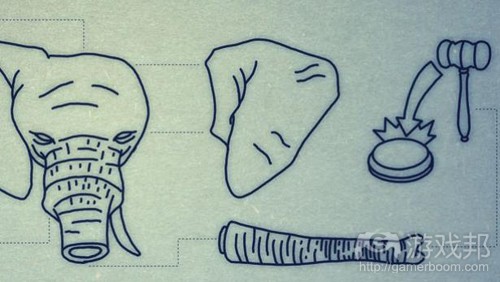辨析“设计是法律准则”观念的谬误
作者:Clint Hocking
有个游戏开发哲学似乎屡次出现,那就是“设计是法律准则”的想法。回到1996年,当John Romero刚刚在达拉斯创建Ion Storm时,将设计作为法律准则或许是当时正需要的想法,因为这能够帮助我们应付行业中的动态变迁。
随着团队的规模逐渐成长,大量的AAA游戏引擎工具将数十年前多才的开发者细化,“设计师”这个角色变得越来越难以定义。Church的《Formal Abstract Design Tools》以及Hunicke、Leblanc和Zubek在The MDA Framework上发表的文章等关于设计形式主义的内容将设计师定义为那些并不具体使用某种工具或引擎进行工作,但更依赖抽象化过程的人。
不幸的是,设计师从代码或者执行工具的缓慢(游戏邦注:在许多背景下这是必要的)退耦导致了误解逐渐加深,对“设计是法律准则”的滥用带来的最好结果是方向错误的开发哲学,最差的情况下会损害我们对游戏及其前景的理解。我觉得现在不需要去讨论设计是否应当成为Ion Storm公司1996年在达拉斯成立时的准则,但是很显然,2011年的设计不是也不应当成为游戏开发的指明灯。
在揭开真相之前,让我们先问问自己,“设计是法律准则”这个表述究竟意味着什么,这种说法可能有多种不同的含义。
首先,这句话可以解释成,设计师或者设计部门在游戏项目中是“愿景的看守者”,他们是游戏将加入何种元素以及这些元素应当如何发挥作用的最终仲裁者。
其次,这句话可以解释成,设计本身是游戏开发的最终目标,也就是说我们最先要考虑的是“设计”,游戏制作的所有工作都应当为设计本身的精美和巧妙服务。
这些解释都不是正确的,至少在我工作所涉及的游戏行业部分的背景下,我认为游戏是整个团队成员合作努力的成果,其目标是意图让玩家体验并且期望能够娱乐玩家或丰富他们的生活。
第一个解释很危险,因为这种想法通常会导致设计保护主义的产生,尤其是那些大型或者经验不足的开发团队。虽然很多情况下确实是设计师来决定项目的整体创造性愿景,但是将他们的决定提升到“法律准则”的高度仍有不妥。
这种对“设计是法律准则”观念的解释来源于设计师的不安全感,他们担心如果游戏所采纳的想法不由他们决定,那么自己的工作将岌岌可危。这种想法中含有的问题是,设计并非“产生可以足以构建到游戏中的优秀想法”的过程。多数想法都不是很好,设计师的工作既不是将优秀想法和劣质想法分离开来,也不是控制游戏将采用何人提出的想法。设计师的工作是掌控符合游戏和潜在优秀想法的艺术和构建层面,使得它们能够恰当地融入到整个创造性产品中。从这个方面来说,设计并非是法律而是法院,需要根据规则来评估想法与游戏的一致性。
第二种解释也很危险,因为这显得过于放纵。在艺术(游戏邦注:泛指所有种类的艺术)中,设计尤为独特,因为这是种以用户为中心的艺术。绘画或雕塑追求的是自身的艺术性,其关注的
主要是风格。后现代文学以自知和自我放纵而著称。被过度装饰的音乐,从风格上可以归类为巴洛克式艺术。相反,厨师长评价晚餐菜肴的艺术性和表现力而非菜肴的味道,这并不会被视为是富有艺术感的表现,他会被视为一个不好的厨师。如果最后盘子上的菜很难吃,那么他作品的美观和典雅完全没有意义。
设计的情况也是如此。脱离对象(游戏邦注:在游戏设计中,这个对象就是玩家)来评价其本身价值的设计就是个劣质的设计。在这种情况下,如果设计是法院的话,那么玩家就是陪审团。我想更具逻辑性的想法是,我们需要支持的想法是——对游戏开发而言,可玩性才是王道。
游戏邦注:本文发稿于2011年8月15日,所涉时间、事件和数据均以此为准。(本文为游戏邦/gamerboom.com编译,拒绝任何不保留版权的转载,如需转载请联系:游戏邦)
Opinion: Design as law
Clint Hocking
There is a philosophy of game development that seems to resurface from time to time which asserts the idea that ‘design is law’. Back in 1996 when John Romero first founded Ion Storm in Dallas, design-as-law may have been an idea that needed its time in the spotlight to help us grapple with dramatic shifts taking place in the industry.
As team sizes grew and the weight of triple-A game engine tools sucked the generalist developers of previous decades into potential wells of increasing specialisation, the role of ‘designer’ became harder and harder to define. In parallel, the foundational works of design formalism such as Church’s essay Formal Abstract Design Tools, and Hunicke, Leblanc and Zubek’s paper on The MDA Framework helped define the designer as someone whose work was not tied to a specific tool or engine, but which relied on an abstract process.
Unfortunately, the slow (and in many contexts necessary) decoupling of designers from code or from implementation tools has led to an increasingly frequent misinterpretation, misuse and abuse of the idea that ‘design is law’ that at best reveals a wrong-headed development philosophy and at worst undermines our understanding of what games are, and what they can be. I don’t really feel a need to speak about whether design was, or ought to have been, law at Ion Storm Dallas in 1996, but it’s clear that in 2011 design is not, nor should it be, the guiding light of game development.
Before debunking it, though, let’s first ask ourselves what the statement ‘design is law’ means, because it can mean a couple of different things.
First, it can be interpreted to mean that designers or design departments are the ‘custodians of vision’ on a game project – that they are the final arbiters of what gets in the game, and how it should work, look and/or feel.
Second, it can be interpreted to mean that design itself is the end objective of game development; that what we are creating is first and foremost ‘a design’, and all of the work that goes into making a game should be in service of the beauty and artfulness of the design itself.
Neither of these things are true, at least not in the context of the part of the game industry that I work in, where games are a collaborative effort put together by teams of people and intended to be played by players looking to entertain themselves or enrich their lives.
The first interpretation is dangerous because it too often leads to design protectionism and to ‘creative siloing’ – especially in larger and/or less experienced development teams. While it is often true that the person specifically tasked with being custodian of the overall creative vision of the project is a designer or comes from a strong design background, it is divisive to imply that that elevates their decisions to the level of ‘law’.
The notion that ‘design is law’ in this sense arises from insecurity on the part of designers who are afraid that if they are not the ones whose ideas are making it into the game, then there is no justification for their jobs. The problem with this thinking is that design is not about ‘generating ideas good enough to make it into the game’. Most ideas are bad, and the job of designers is neither to separate good ideas from poor ones, nor to control whose ideas make it into the game. The job of designers is to master the art and craft of iterating forward on relevant and potentially good ideas to the point at which they can be properly evaluated for inclusion in the creative whole. In this sense, design is not law, but rather, design is the courts whose job is to evaluate conformity with a set of principles.
The second interpretation is dangerous because it is self-indulgent. Design in the arts (in general – but perhaps particularly so in the case of game design) is unique in that it is a user-centric art. Painting or sculpture in service of its own artfulness is a stylistic concern. Post-modern era literature is often knowingly self-aware and self-indulgent. Music that is overwrought can be classified stylistically as Baroque. Conversely, the chef who values the artfulness and expressiveness of the act of cooking over the taste of the final meal is not considered to be making artistic statements – he’s considered to be a bad cook. It doesn’t matter how beautiful and elegant his work is in the kitchen if what ends up on the plate tastes awful.
It’s the same with design. Design that values the design itself over its object – in our case the player – is poor design. In this sense, if design is the courts, then the player is the jury. And to extend the metaphor to its logical conclusion, I think the idea we need to embrace is that play is law. (Source: Edge)
下一篇:分析游戏设计标准之长期动机








































 闽公网安备35020302001549号
闽公网安备35020302001549号